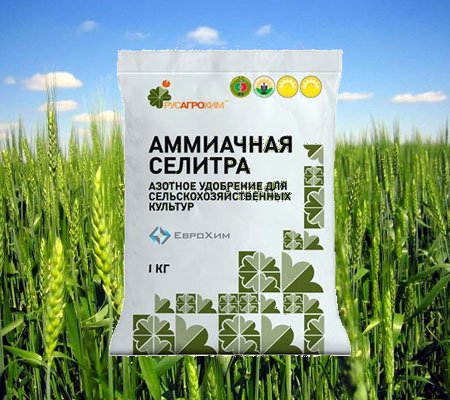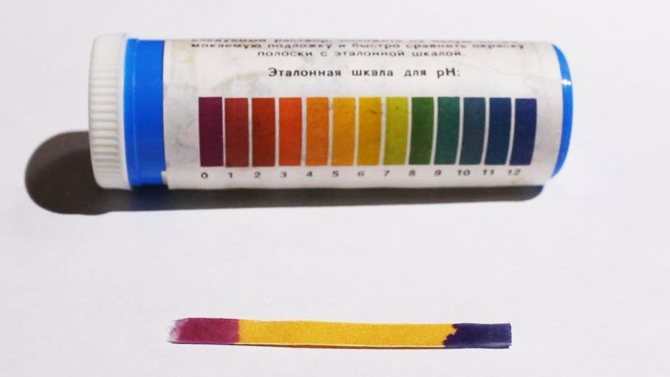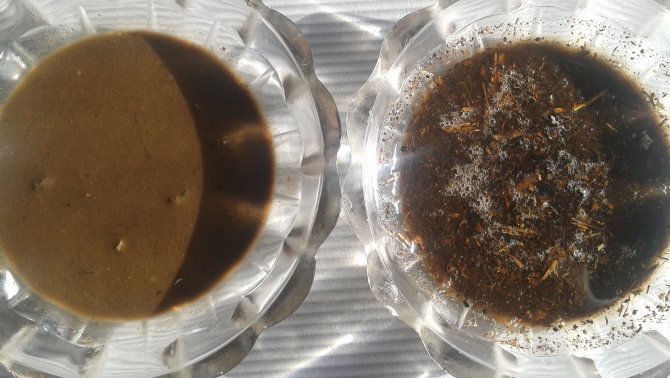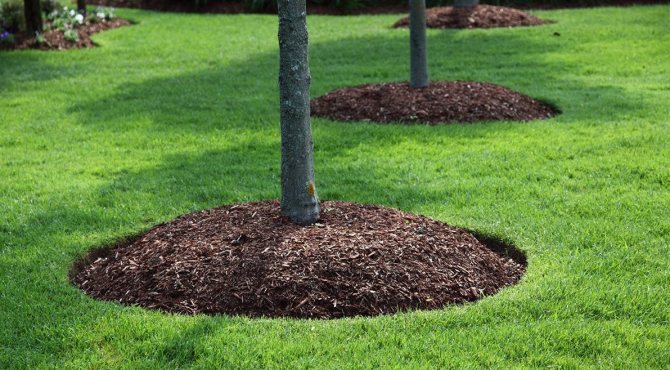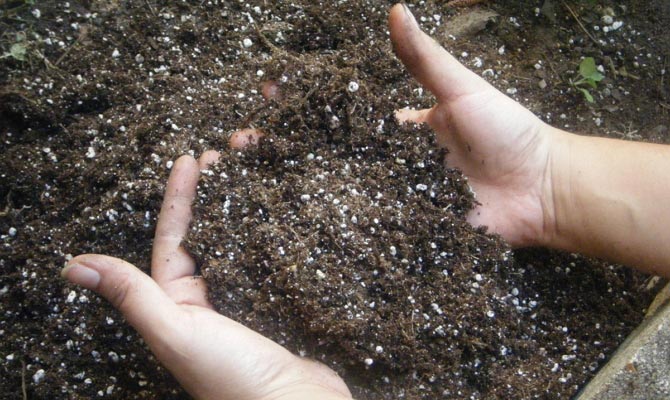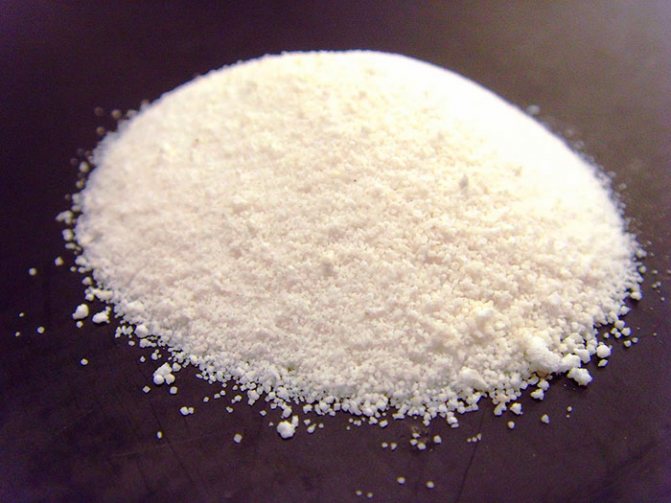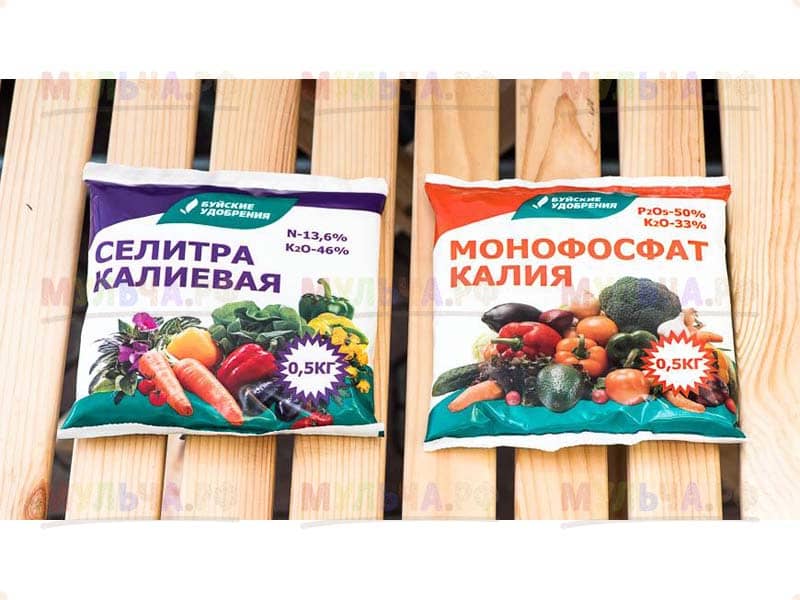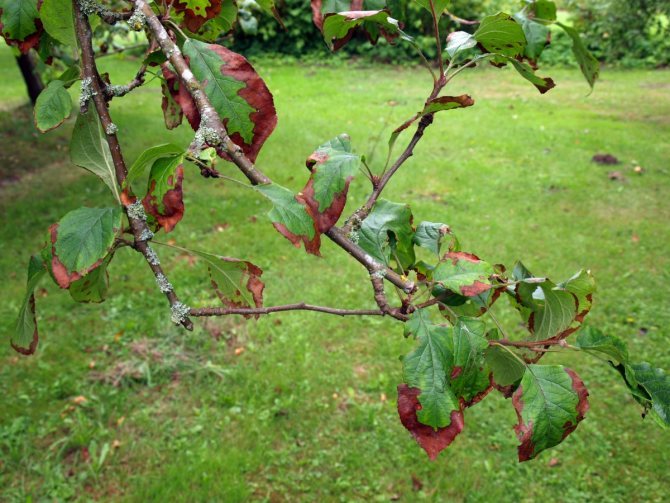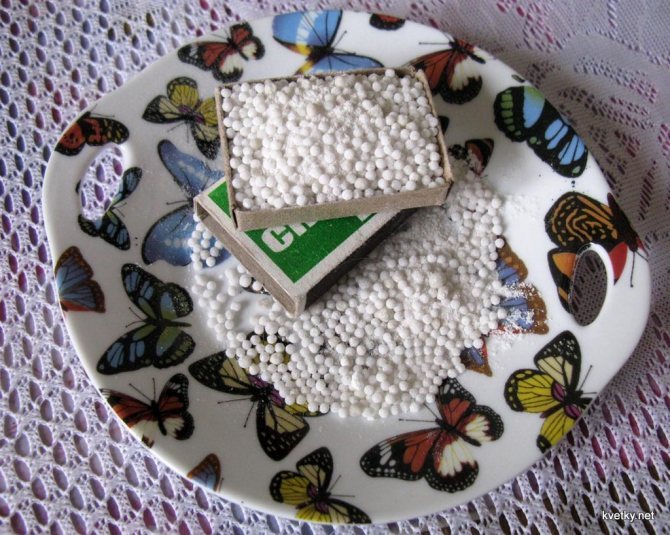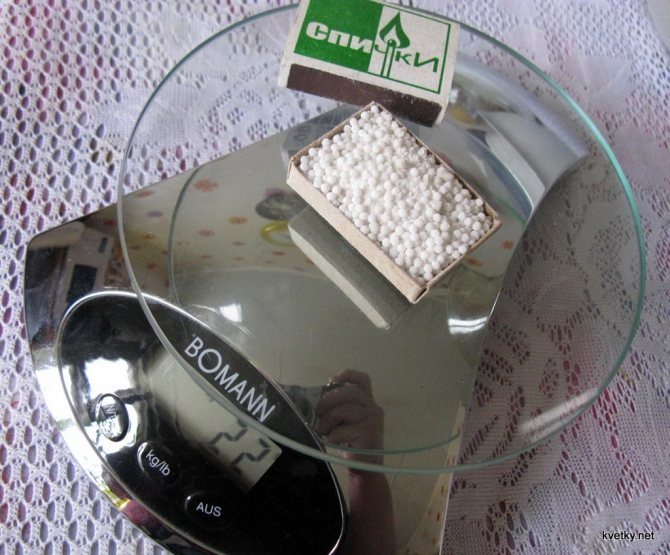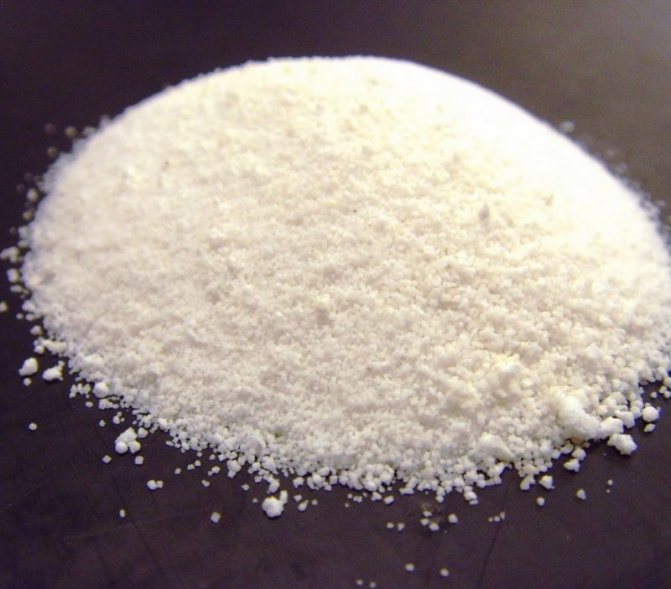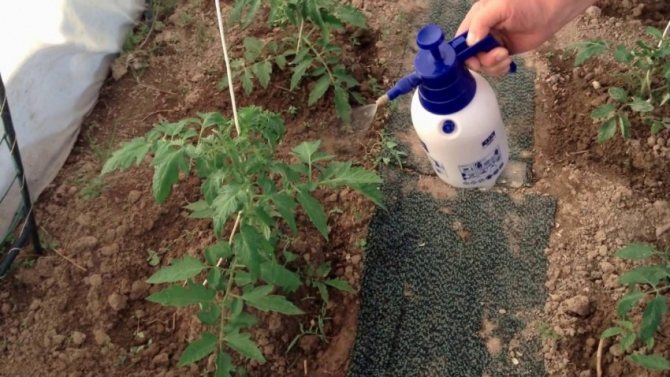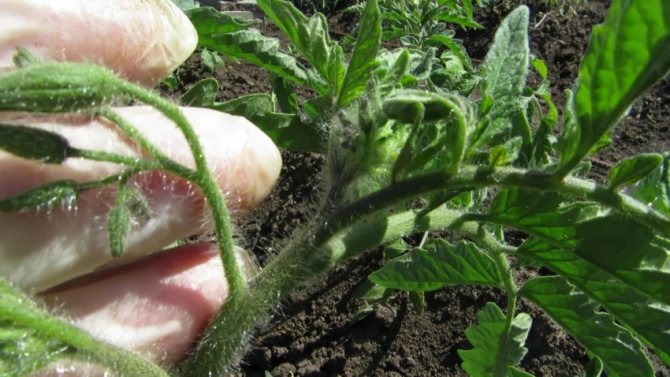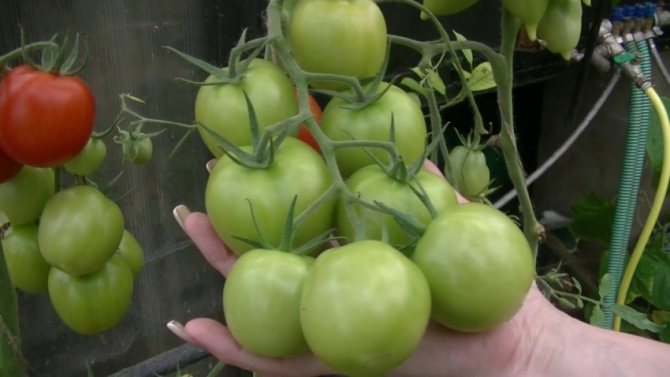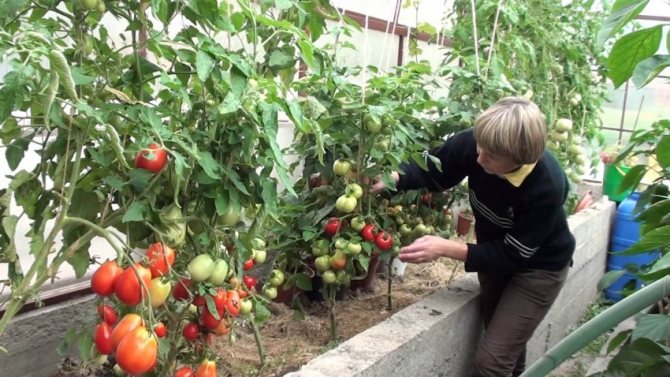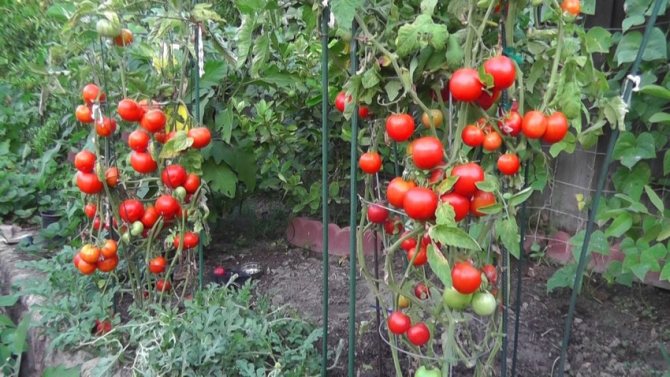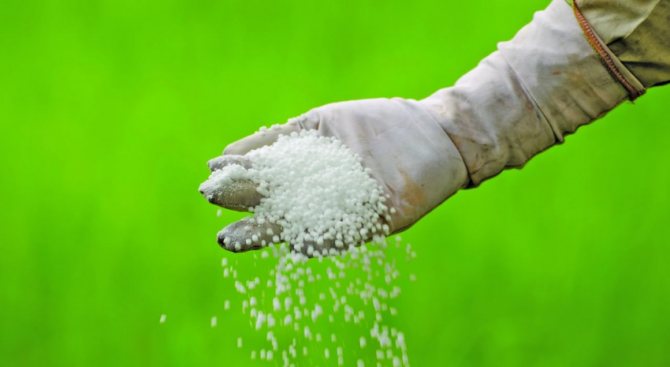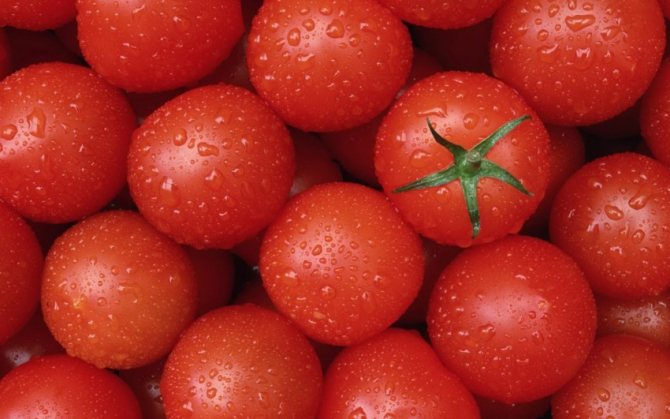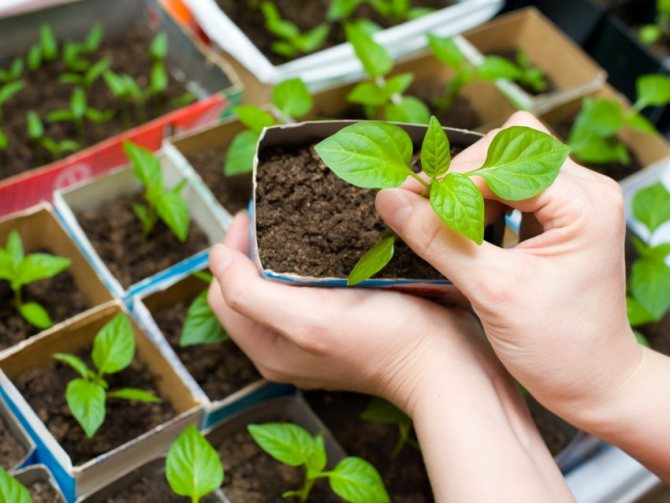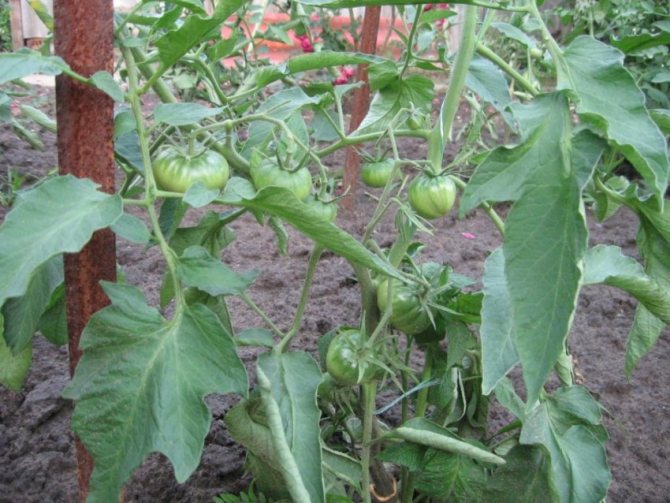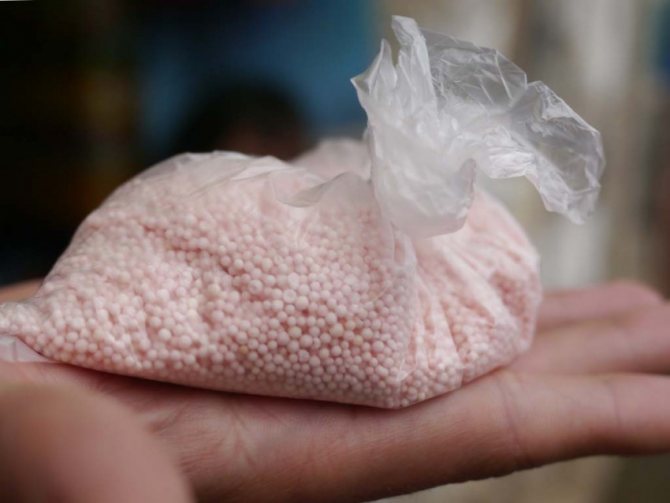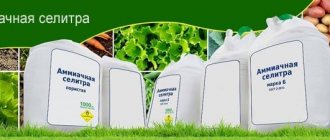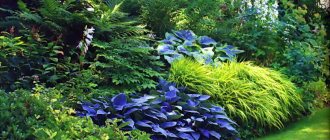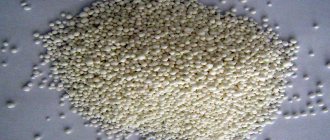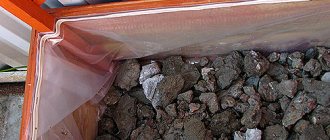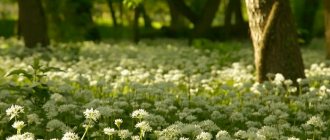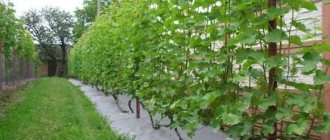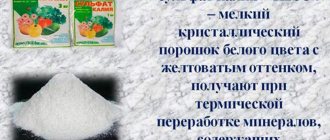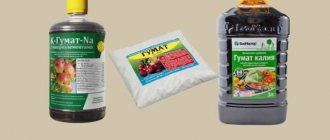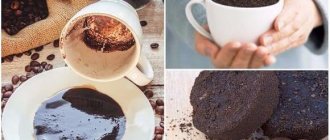Category: Mineral fertilizers Read: 8 min Views: 3 588
Potassium nitrate (potassium nitrate) is a popular agricultural fertilizer. Some sources call Indian potassium nitrate. Formula of potassium nitrate: KNO3, where the main elements are nitrogen and potassium. Their combination is very effective, since nitrogen accelerates the development of horticultural and vegetable crops, and potassium helps to increase the suction power of the roots.
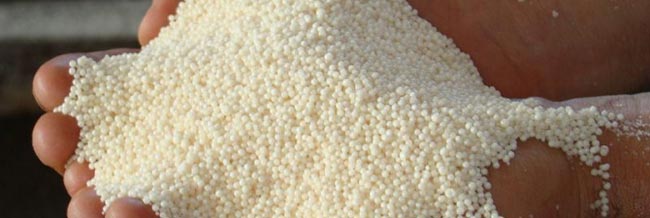
After such feeding, the plant begins to actively absorb nutrients from the soil. In addition, cellular respiration is enhanced, because potassium nitrate is a catalyst for some biochemical reactions. Sufficient saturation of plant cells with oxygen helps to strengthen the immune system and increase the protective forces. And the less the plants get sick, the greater the yield will be.
Saltpeter is an effective top dressing, so it has been used in agriculture for over 30 years. Usually potassium nitrate is introduced as an additional food for plants for which chlorine is harmful. Potassium nitrate is great for fertilizing strawberries, blueberries, raspberries, grapes, beets, carrots, and tobacco.
What are the features of potassium nitrate?
The additive is characterized by the following properties:
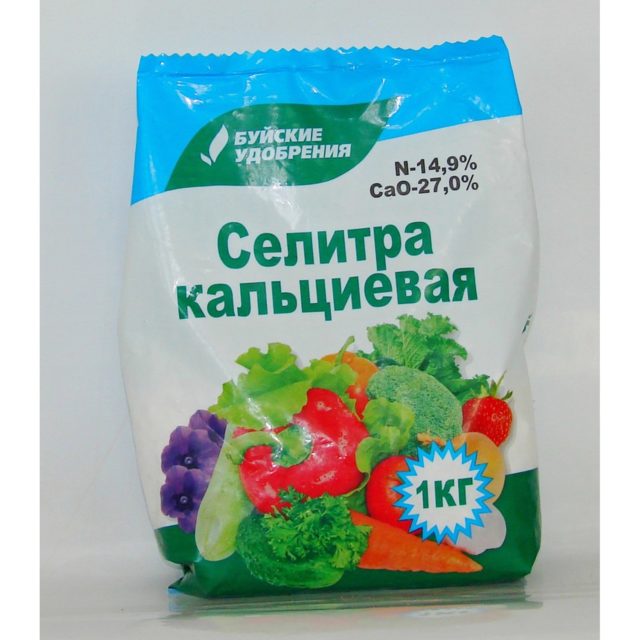

Potassium nitrate, or potassium nitrate - a mineral fertilizer that is widely used in agriculture
- has the appearance of white, sometimes yellowish, odorless crystals, resembling powder;
- sold in bags with a capacity of 1 to 50 kg;
- well soluble in water, hydrazine, glycerin, liquid ammonia (but not ether or ethanol) are suitable for the same purposes;
- melts at very high temperatures;
- flammable when heated, posing a hazard;
- the composition is not volatile;
- free from harmful additives;
- does not affect soil acidity;
- effective for soils that are poor in potassium and plantations that cannot tolerate chlorine (potatoes, grapes, tobacco);
- it is used on open and closed soil: in the garden, flower bed, when feeding indoor flowers;
- combines well with other water-soluble feeding agents;
- cakes in case of prolonged storage in unsealed packaging.
Analogs
Among the analogues of potassium nitrate, you can see the store-bought product MULTICROP 14-0-44. It is a water-soluble top dressing rich in potassium and nitrogen. She is watered, following the instructions, garden and horticultural crops, flowers and ornamental plants.
An alternative to purchased potassium nitrate is homemade. Making it yourself at home is not difficult. You will need to stock up on the following ingredients:
- potassium chloride - 100 g;
- ammonium nitrate - 95 g;
- distilled water - 350 g.
The process of creating homemade Indian saltpeter involves the following sequence of actions:
- Potassium chloride is dissolved in hot distilled water. It is preferable to use a glass container like a bottle.
- The resulting solution is filtered through several layers of gauze. The liquid should be transparent, pinkish.
- It is heated until the first bubbles appear. Pour in the second ingredient. Stir. Allow the liquid to boil for 3 minutes until completely transparent.
- Allow the solution to cool at room temperature for 3 hours.
- The cooled liquid is sent to the refrigerator for 2 hours.
- Transfer the liquid to the freezer for another 3 hours.
- The upper layer is discarded, leaving a precipitate.
- The precipitate is dried on a paper towel at room temperature for 3-4 days.
At the exit, about 50 g of potassium nitrate is formed.
What is this remedy used for and how does it work?
Potassium nitrate is used to influence vegetation in the following directions:
- improves the absorption of substances by the root system, increases its branching;
- balances photosynthesis;
- accelerates growth;
- improves the quality of tissue structure;
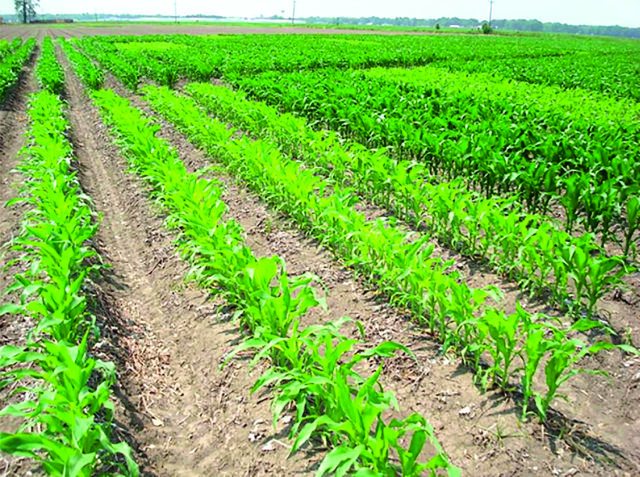

Most often, it is introduced as an additional food for plants that categorically cannot tolerate chlorine.
- increases stress resistance, frost resistance and immunity;
- increases productivity (number and size of fruits);
- prevents cracking of fruits, increases their safety;
- improves the taste of fruit and berry products, contributing to the accumulation of sugar (beets, grapes);
- prevents the development of bacteria and fungi.
Useful properties of potassium-nitrogen feeding
This fertilizer is a complex fertilizer, as it has a wide spectrum of action. Its use in the garden will help achieve the following effects:
- stimulates growth and strengthens the root system of planting, which directly affects the quality and quantity of the crop;
- accelerates the process of photosynthesis, thanks to which it will be possible to get a good harvest even in regions where summer lasts only a couple of months;
- activates the immune system of plants, making them more resistant to frost, temperature extremes and pest attacks;
- stems and green mass receive the necessary minerals and trace elements, due to which the plantings develop correctly;
- the appearance of the fruits improves, they become voluminous and grow at the same rate;
- since top dressing stimulates flowering and improves the ovary, the yield level increases;
- fruits become stronger and better tolerate transportation.
Also, the use of such fertilizer prevents the growth of bacteria and fungi.
For which crops is potassium nitrate most commonly used?
Expert opinion on potassium nitrate
A successful combination of the two main components of plant nutrition. In this variant, nitrogen and potassium do not interfere with the absorption of each other, as when using mixtures with their separate inclusion. Stimulates the development of powerful roots, strong stems, improves the palatability of the fruit. Not subject to simultaneous application with organic fertilizers.
Anatoly Baykov
The most effective fertilization with this agent is the following varieties of vegetation:
- root vegetables (beets, carrots);
- berry plants (tomatoes, currants, strawberries, raspberries, blackberries, blueberries, grapes, gooseberries);
- fruit trees.
A lesser effect is observed when feeding potatoes, cabbage, radish, greens.
Application in the garden
Most often, potassium nitrate is used in the rural industry. The fact is that it is considered an excellent plant fertilizer. It is used for certain varieties that do not react well with other fertilizers. This group includes berry and citrus plants, grapes, beets, tobacco. Used as a strengthening agent for plants grown in a greenhouse or room. It will strengthen the root system, stabilize photosynthesis, and improve tissue structure.
The drug is used in the form of root and foliar additives. This fertilizer contains almost no chlorine, so it can be applied to potatoes, grapes, tobacco and other plants without any problems. Carrots and beets, currants, flowers respond well to the drug.
During the fruiting of cucumbers, they can be supported by potassium nitrate. This will increase the yield of the plant, the greens will not increase in growth.Almost all feeding will be spent on the formation and ripening of cucumbers.
What methods of feeding with this product are the most productive?
The introduction of dry matter is practiced, but the fastest effect is observed when using exactly a 2% aqueous solution.
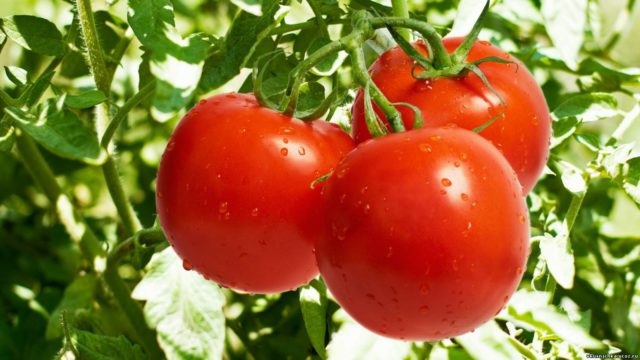

Potassium from the composition of this fertilizer is much more useful for fruit trees and berries, including tomatoes
There are two common methods of using potassium nitrate solution:
- Root dressing. It is carried out once every 14 days by applying a working solution under the plant at the rhizome.
- Foliar feeding is spraying with a sprayer. It is carried out 2 to 4 times during the entire growing season. Requires a higher concentration of the substance in the solution (about 2.5 g / l), since some of it evaporates from the foliage and is washed off during subsequent watering. Funds consumption:
- for vegetables, flowers and ornamental plantings - 0.7-1 l / m2;
- for berry - 1 l / m2;
- for fruit trees - 1.5-7 l / m2 (depending on the age and density of the tree crown).
Water the vegetation liberally after each use.
ATTENTION! Do not mix crystals of potassium salt of nitric acid with organic fertilizers (compost, peat, straw, sawdust, manure).
Compatibility with other fertilizers
It is not allowed to mix with organic fertilizers - peat, manure, sawdust and straw. For potatoes and cabbage, this composition works great together with other fertilizers. It is recommended to mix saltpeter with cabbage with calcium, and in the case of potatoes, phosphorus is added to it. Carrots and beets respond well to pure saltpeter, but it is allowed to mix in calcium.
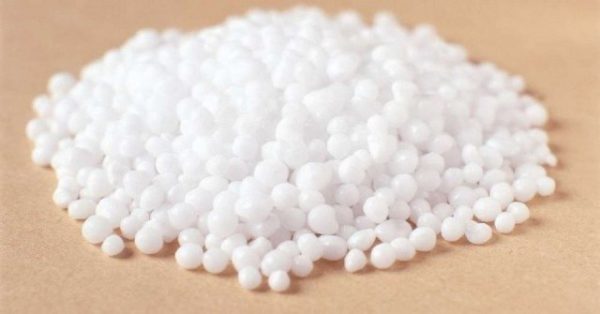

Potassium nitrate granules close up
Potassium nitrate should be applied to light soils in spring, because potassium is poorly retained in such soil and is quickly washed out. Fertilizers are highly acidic, so it is recommended to use them in combination with calcium or lime. In chernozem areas characterized by alkaline reactions, potassium does not have a negative effect on crops.
Best time to use
It is recommended to use the supplement at certain times:
- For the first time, you need to add the substance in the month of April.
- The second time - during the sowing of the soil (May).
- Provide nitrogen to the soil from the beginning of bud formation until the fruit ripens.
- In the summer, feed the vegetation foliarly, trying not to overdo it with the amount of the substance introduced. Stop such feeding should be a month before harvesting.
- Autumn fertilization of fruit trees will increase their frost resistance.
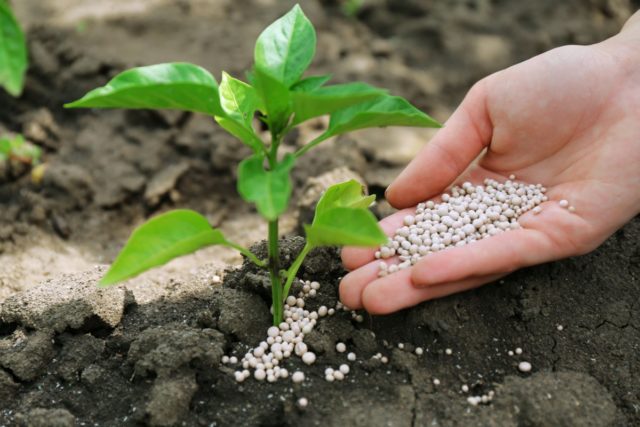

After the introduction of potassium nitrate, the quality and quantity of the crop is noticeably improved.
Description and application
Since potassium nitrate is predominantly found in the lands of India, it is often called Indian saltpeter. It should be borne in mind that this component is initially present in plants, but its amount in them is minimal. The formula of potassium nitrate is KNO3, the component contains 1/3 nitrogen and 2/3 potassium nitrate, which is of the greatest value for garden crops. Nitrogen is responsible for the growth of green mass, and potassium stimulates flowering and fruiting. This crystalline compound looks like a colorless powder and does not have a pronounced odor. Also, it does not pose a threat to living organisms.
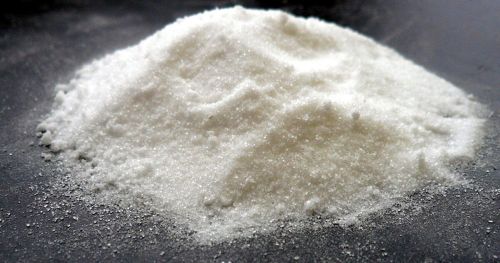

The product is completely soluble in water, which makes it more often used for the preparation of nutritious irrigations. The advantage of this fertilizer is that it can be used on any soil: sandy, loamy and clayey. The optimal time for feeding with such a product is the summer months. The fertilizer is universal, it can be used as an additive for root crops, berries, shrubs, fruit trees, and flowers.
Potassium nitrate is most useful for:
- carrots and beets;
- strawberries, wild strawberries, currants, grapes, blackberries;
- tulips, daffodils, lilies.
- How to feed lilies.
- Fertilizers for the quality and quantity of carrots from planting to harvest.
- Top dressing of carrots in the open field.
- Fertilizers that are needed for growing beets in the open field.
- Top dressing for currants in the spring.
- Top dressing of grapes in the spring.
- How to feed grapes in the fall.
- Top dressing of blackberries.
- Tulips in early spring are useful trace elements.
Professionals do not recommend using such a top dressing for processing beds with potatoes, herbs, radishes and cabbage. To get a good harvest of these crops, it is recommended to use other fertilizers.
Top dressing with potassium nitrate increases the acidity of the earth. If the soil has an initially acidic pH reaction, the fertilizer is added in minimal quantities.
Potassium nitrate - instructions for use for garden crops
Farmers and gardeners advise using potassium nitrate for specific vegetable crops:
- Cucumbers. Fertilized with a solution in the fruiting phase. The yield increases, but not the growth of greenery (stems and leaves).
- Tomatoes. They are shown watering seedlings, when 4 developed leaves appear in it. Also, re-treatment with potassium nitrate is necessary a week before planting seed in the soil and during picking of bushes.
Root application of the drug in the tomato flowering phase will increase the yield by 40%.
- Roots. Potatoes, carrots, radishes and other crops are supplied with components of potassium nitrate by introducing crystals of a dry preparation directly into the ground (up to 50 g / m2) during spring digging. Root crops are planted a few days later. Consider:
- potatoes are processed during hilling, at the peak of potato tops development. It is recommended to mix this supplement with phosphorus for the best effect;
- cabbage and radishes are fortified with potassium nitrate mixed with calcium;
- beets and carrots prefer a clean product.
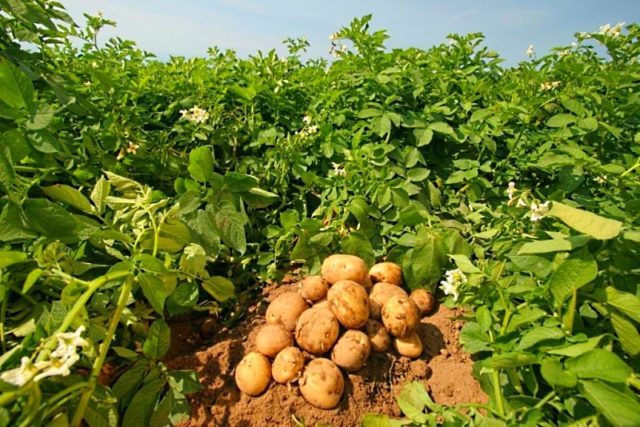

As a fertilizer, potassium nitrate can be applied under plants both in dry and liquid form.
How to use potassium nitrate
Potassium nitrate is used throughout all seasons. The first top dressing is applied in the spring, immediately at the beginning of the growing process.
Method of introduction: digging or plowing.
After that, it is used for fertilization, both root and root
... In the first case, fertilization is applied immediately under the root, in a circle near the trunk, a hole for planting. The foliar method consists of spraying or simply wetting the foliage. The latter method is more effective, since it is through the surface of the leaf that better absorption occurs than through the roots.
The most optimal use of potassium nitrate is a complex method that combines both spraying and watering at the same time
.
To apply fertilizers outside the roots, more substance is required, since evaporation occurs through the leaves. Also, some of the fertilizer may simply be washed away by the rain. During the growing season, there is a 4-time application of dressings, with an interval of 10 to 15 days.
On a note:
potassium nitrate can also be used in dry form. It is even better for fertilizing root crops. For other crops, the liquid form manifests itself more effectively.
As for exceeding the amount of dressings, this is undesirable, as this will affect the fruits. In their composition there will be an excess of the concentration of nitrates.
Dosage:
• for the preparation of a solution for root fertilization, saltpeter is used in a volume of 15 to 25 grams per 10 liters of clean water .; • for spraying, make a large concentration, more than 25 grams for the same amount of water; • the last time feeding is applied three to four weeks before harvesting the fruits.
Once again, it is worth saying that you should not exceed the number of dressings more than 4 per year, as this will increase the concentration of nitrates in the fruits.
.
Flowers and other decorative crops of open areas
Flower and ornamental plantings of flower beds, garden plots also need additional nutrients, including potassium nitrate.
It is added in the amount of:
- with root feeding - 1.5 g / l;
- when spraying - 2.5 g / l (consumption - 0.7 l / m2).
It is used no more than 2 times per season, as a rule, on the eve of planting flowers in a flower bed (adding a dry preparation when digging up the ground). Thus, the soil is enriched with minerals. Sub-root fertilization with a solution is carried out several days before flowering.
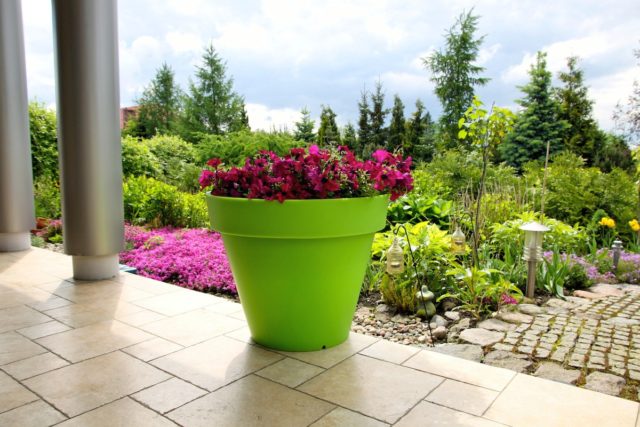

Saltpeter targets some varieties that do not react well with other types of fertilizers
First of all, potassium nitrate is shown to flowers:
- small-bulbous;
- rhododendrons;
- dahlias, tulips, gladioli;
- lilies;
- clematis.
What plants need nitrogen
First of all, this microelement is necessary for vegetable crops. In order to grow a rich harvest at home, you need to fertilize with nitrogen such vegetables as pumpkin, cabbage, zucchini, eggplant, peppers, potatoes. They need to be fed during planting and during active growth and flowering. Also, large quantities of nitrogen are required for fruit and berry plants (raspberries, cherries and blackberries.) And ornamental crops (rose, peony, violet, etc.). These crops need a higher nitrogen content in the soil. When using ammonium nitrate as a fertilizer for these plants, you need to use about 25 grams. fertilizers per 1 sq.m.
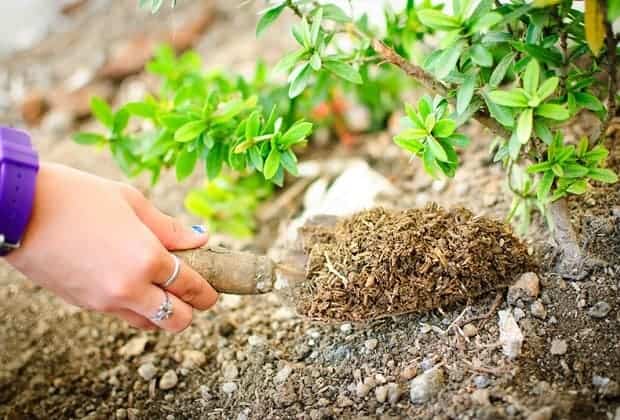

Slightly less nitrogen is required for cucumbers, tomatoes, beets, corn cobs, carrots and greens. Also, a large amount of this element is not required for annual flowers, currants, apples and gooseberries. The site for these plants must be fertilized with ammonium nitrate at the rate of 20 grams. for 1 sq.m.
An even smaller amount of nitrogen (15 grams per square meter) is required for early potatoes, leafy vegetables, radishes and onions. The same amount of top dressing must be distributed in the places of planting of bulbous ornamental plants and pears.
Only 8 gr. for 1 sq.m. nitrogen fertilization is required for crops such as peas, spicy crops, beans, azalea, heather, poppy.
Rules for the use of potassium nitrate for indoor plants
According to experts and consumer reviews, the dosage prescribed for flower beds, in the case of indoor plants, should be halved. That is, use a working solution at a concentration of 0.5 g / l.
Fertilizer is especially useful for:
- violets;
- begonias;
- orchids;
- ferns and other exotics of subtropical origin.
Ornamental deciduous plants are preferred by watering with a complex solution twice a month. To prepare it you will need:
- water (1 l);
- potassium nitrate (0.1 g);
- ammonium nitrate (0.4 g);
- simple superphosphate (0.5 g).
The working solution cannot be stored; after preparation, it must be used immediately.
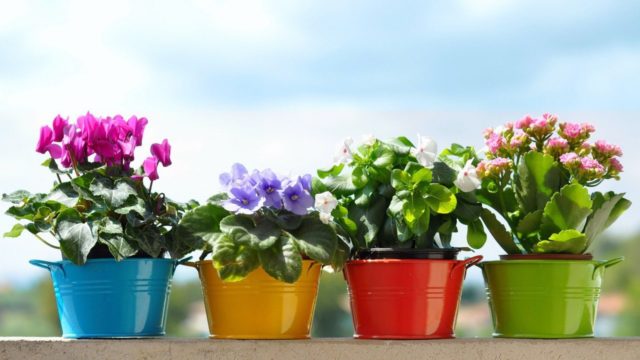

In the greenhouse cultivation of vegetables and indoor plants, saltpeter is used to strengthen the plants.
Reviews of gardeners
Reviews of gardeners and gardeners on the use of Indian nitrate are mostly positive. Despite the abundance of modern fertilizer mixes, the tool does not lose its popularity. It's proven, easy to use, affordable, effective, and delivers good results.


Potash nitrate is widely used in household plots to increase the productivity of garden and horticultural crops, "revitalize" ornamental plants and flowers. Strict adherence to the instructions and compliance with safety measures when working with potassium nitrate allows you to achieve excellent results.
Precautions and storage of the drug
When choosing KNO3 for fertilizing plantings, remember that potassium nitrate is a dangerous substance:
- is an oxidizing agent that quickly reacts with various combustible substances;
- toxic;
- a high concentration of the solution can cause irritation and chemical burns in humans.
Store the substance in a sealed package, separate from other fertilizers and household chemicals, as well as away from flammable substances and heaters. The bait bag must be protected from direct sunlight.
Safety precautions during use:
- Do not inhale, taste, or apply the solution to your skin.
- Wear gloves, closed clothing and shoes when handling working solution and dry granules. When foliar feeding (spraying), protect the respiratory tract with a respirator and eyes with special goggles.
- Do not use kitchen utensils when handling saltpeter.
- When heated, the substance is very likely to catch fire or explode, so do not use it in hot weather. For the same reason, do not mix the product with organic substances. Do not smoke or start a fire near it.
First aid:
- in case of contact with the substance, rinse it with cold water;
- in case of contact with eyes, rinsing is also advised (during which the eyelids should be kept open);
- If you are burned, apply a sterile dressing to the affected area and see a doctor.
Security measures
Read the instructions before using potassium nitrate. Since concentrated vapors of nitrate are unsafe for human health, safety precautions must be taken. You can work with feeding only with rubber gloves, and special glasses are used to protect the eyes. You need to use saltpeter in tight clothing and if you have a respirator.
If the solution comes into contact with the skin, immediately rinse it off with plenty of running water and treat the affected area with an antiseptic.
Since potassium nitrate is an oxidizing agent that interacts with combustible substances, it is stored in a closed container or tight bag. In no case should you leave saltpeter in dangerous proximity to flammable and flammable substances. It is forbidden to smoke in places where potassium fertilizers are stored, and children are not allowed there.
Fertilizing plants with potassium nitrate, you need to take care of their safety. In order for the solution to be better absorbed and to compensate for the lack of moisture, top dressing should be combined with watering. It is not recommended to abuse saltpeter on acidic soils, since the fertilizer oxidizes the soil. Potassium nitrate can burn plants, so feeding is done carefully, not getting on the stems and leaves (if the solution is highly concentrated).
DIY nitrogen fertilizers (video)
You can not apply fertilizers to sick or oppressed plants for unknown reasons. In some cases, this can only aggravate the situation and lead to their death. First, it is necessary to carry out the necessary sanitary measures and establish the cause, and only then, after the resumption of growth processes, feed. Also, you cannot feed indoor plants immediately after transplanting and during dormancy.
| Print Press Print or CTRL + P to print the page | 4.75 Rating 4.75 (2 Votes) |
The amount of nitrogen in various types of fertilizers
Mineral
Industrial nitrogen fertilizers are conventionally divided into simple and complex. The former contains one basic chemical element and several others in small quantities. As part of complex up to 3 basic elements and several additional in small quantities.
Each type of nitrogen-containing fertilizer differs in the proportion of nitrogen contained in the total mass.
Simple mineral fertilizers:
Ammonia:
- liquid ammonia - 82.3%;
- aqueous ammonia - 17-21%;
- ammonium sulfate - 20.5%;
- ammonium chloride - 24-25%;
Nitrate:
- sodium nitrate - 16.4%;
- calcium nitrate - 13.5-15.5%;
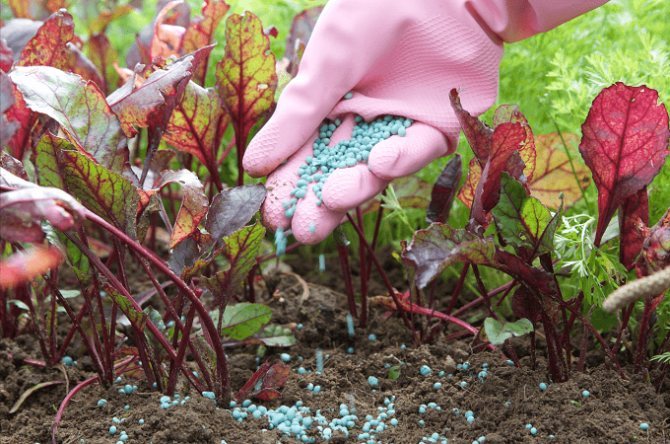

Complex:
Ammonia-nitrate:
- ammonium nitrate - 34-35%;
- lime-ammonium nitrate - 20.5%;
- ammoniaates based on ammonium nitrate - 34.4 -41%;
- ammonia based on calcium nitrate - 30.5-31.6%;
- ammonium sulfonitrate - 25.5-26.5%.
The rate of absorption of fertilizers by the soil does not depend on the concentration of nitrogen.
Phosphoric
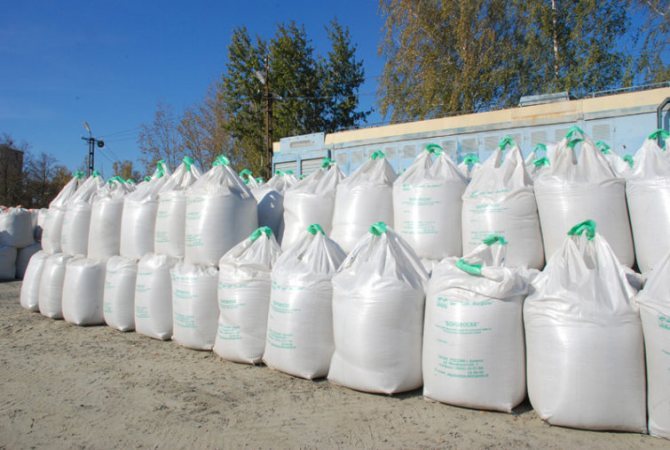

Phosphorus fertilizers containing nitrogen are called nitrogen-phosphorus fertilizers. These are complex two- or three-component fertilizers based on nitrogen, phosphorus, potassium.
What is rich in fertilizer
| Substance name | Benefit |
| Nitrogen | It is necessary for plants for the normal course of intracellular processes. Stimulates growth, helps to increase yields. Improves the quality of ripe fruits. |
| Calcium | Required for photosynthesis and leaf growth. Strengthens the root system, slows down the decomposition of roots. |
| Magnesium | Participates in the process of movement of phosphorus within cells, as well as in carbohydrate metabolism. It controls the activity of oxidative processes. |
Additionally, the fertilizer contains an aqueous solution.
Ordinary ammonium nitrate has a richer composition than its ammonium-limestone counterpart. However, the latter option is much safer.
Influence of soil temperature on phosphorus absorption
The element phosphorus is assimilated at a temperature of +15 - 18 degrees, because under such conditions soil microorganisms wake up and decompose the fertilizer. When the temperature drops, the bacteria freeze, and at this moment, temporary starvation in plants may occur.
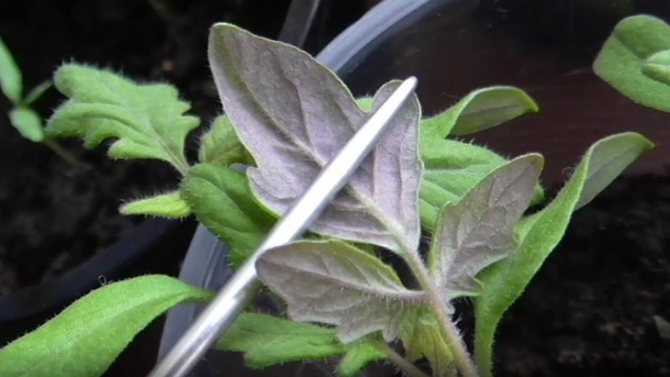

Most of the questions come from novice gardeners who are growing vegetables for the first time in their lives: why there are signs of a lack of phosphorus on the leaves, if fertilizers were applied correctly and at the right time. The answer is because soil bacteria do not function at low temperatures. As soon as it gets warmer, the nutritional process returns to normal.
Important! At this point, there is no need to try to additionally feed the seedlings, as there will be an overdose and the roots will get burned. The best way is to cover the beds with polyethylene until warming. If the plants are in the greenhouse, turn on the heating or water the soil with warm water
Storage features
When storing potassium nitrate, it is important to consider the following points:
- Fertilizer packaging must be secure and sealed.
- The hygroscopicity of potassium nitrate is insignificant, but still the fertilizer should be stored in a dry place. Potassium nitrate can absorb small amounts of moisture. In this case, the fertilizer can be caked. It is enough to dry it and break it mechanically. The properties of potassium nitrate are not affected.
- Potassium nitrate is an explosive substance. Do not store it near incandescent bulbs (which turn on), heating and heating devices, flammable substances and alkaline compounds.
- The fertilizer should be stored out of the reach of children and animals.
Potassium nitrate is a universal fertilizer that can be used for almost all plants. The substance is a chemical compound, so you need to work with it carefully. It is recommended to buy fertilizer immediately before use and in limited quantities so as not to store it for a long time
Comparison of ammonium nitrate and ammonium-lime
The corresponding research in 2005-2006 was carried out on the personal fields of the Stavropol Research Institute of Agriculture.
Experimental results:
| Indicator | Ammonium nitrate | Amma-lime |
| Increased sugar beet yield | +44 c / ha | +146 c / ha |
| Efficiency of early feeding of winter wheat (chernozem) | +22% | +17% |
| Efficiency of early feeding of winter wheat (chestnut soil) | +16% | +13% |
Additionally, it was found out that ammonium nitrate is the least effective in relation to sunflower crops.This type of plant requires moderate to small amounts of nitrogenous fertilizers. An increase in the permissible dosage negatively affects the yield.
